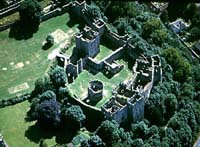| |
 |
Ludlow (Shropshire) Ludlow Castle |
After the Norman Conquest, land on the Welsh border around Ludlow was given to the de Lacy family from Lassy, near Falaise in southern Normandy. On a prominent bluff bounded to the west by the River Teme and to the north by the River Corve, Hugh de Lacy began construction of a castle in c. 1085 which played a key role in the subjugation of the region.
The castle included a large outer bailey c. 8ha (4 acres) in extent, and an inner bailey. The outer bailey, walled in the second half of the 12th century, may have been used to muster troops for the Earl of Pembroke's invasion of Ireland in 1170. The gatehouse on the east side opens on to the market street of the new town founded at that time.
The enclosure wall of the inner bailey is mostly early 12th century and has four flanking towers of square plan. At this time the original gatehouse was converted into a keep and a new entrance was then built alongside. A small inner court had been formed by buildings north of the keep by the late 12th century. A remarkable building of c. 1140 is the chapel of St Mary Magdalene, of which the circular nave survives, although the apsed chancel does not.
Bibliography
Pevsner, N., 1958. The Buildings of England, Shropshire (London, Penguin), 181-3
Shoesmith, R. and Johnson, A. (eds), 2000. Ludlow Castle: Its History and Buildings (Almeley)